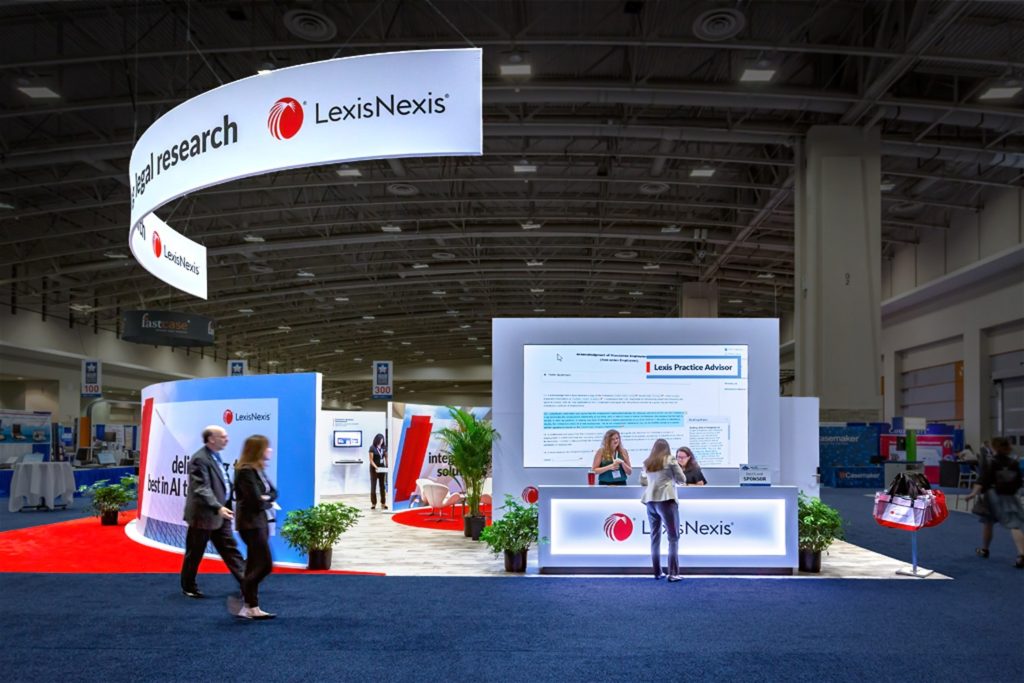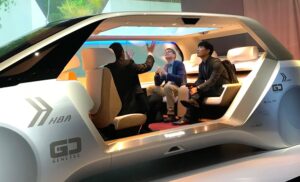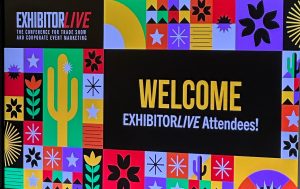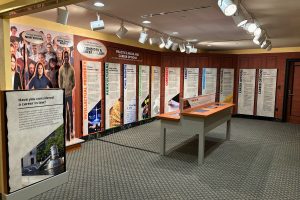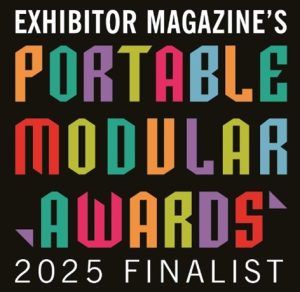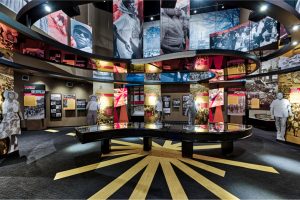Can you believe we’re more than halfway through 2019? It feels like it was just yesterday that our teams were at EXHIBITORLive, marveling at the latest and greatest in trade show design and technology.
Earlier in the year, we predicted what attendees might begin to see on the show floor in 2019. As the year progressed, we spotted six trends that are becoming more prominent that exhibitors should keep an eye on:
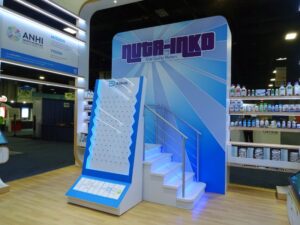 Trend One: Nostalgic Engagement
Trend One: Nostalgic Engagement
From Plinko boards to cornhole, exhibitors are taking show attendees back to a fun memory from their past. Show floors are crowded spaces, and brands are craving a more hands-on, authentic experience for their customers and prospects. Along with creating engaging experiences, exhibitors are also going retro with their booth design. “This is definitely something I’m seeing more of as I’m walking the trade show floor,” said Stephanie Matlock, Account Executive for Exhibit Concepts. “One great example that immediately comes to mind is Clif Bar, who hung records on their booth at the Natural Products Expo Show earlier this year.”
Chris Beckstedt, Account Executive for Exhibit Concepts says, “Exhibit Houses are being challenged to create these solutions rather than agencies right now. Clients are looking for that one-stop shop, and it’s now an expectation rather than just a desire.”
Taking a page from our own playbook, the booth we created for EXHIBITORLive 2019 featured a wall display of old-school lunchboxes reminiscent of comics from the 1980s. The lunchboxes were stuffed with retro toys such as a plastic dinosaur, foam plane gliders, and greeting cards showcasing a project our team completed.
If your brand is going to exhibit, making a nostalgic play is an effective way to draw show attendees into your booth. Whether you’re displaying products or reinforcing a brand message, there are plenty of ways you can factor in nostalgia – either it’s in the design or the engagement.
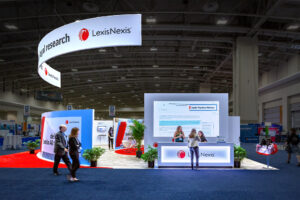

Did you notice that exhibits are curvier than ever? So did we.
With a multitude of configurations and design possibilities, exhibitors are becoming strategic when it comes to leading people through their booth. Curving structures keeps attendees on a path just like a hiking trail or museum would, so that attendees aren’t missing important details and messages as they explore.
“It’s similar to how you’d lead people through an aquarium, like the Newport Aquarium,” said Beckstedt. “You’re placing products or engagements along the path and the architecture leads them through the booth. It prevents attendees from leaving quickly without establishing what your brand’s message is and what action you’d like them to take. Finding the right partner that can creatively think through these details and help you tell that story is extremely important.”
Take a page from your favorite museum: your booth should function just like an exhibit as it leads attendees through the story your brand wants to tell. Don’t provide an easy way out; make sure your architecture directs attendees down the path you want them to take.
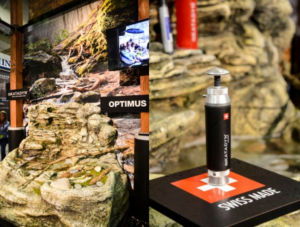

Bringing the outdoors inside can bring your booth’s look to life, literally! While it’s not new to use potted plants – faux or alive – to fill or accent space, incorporating live plants, mimicking natural textures, or the use of natural materials in a booth’s architecture has started to appear across convention centers everywhere.
“Just about every show I’ve gone to this year, I’ve seen live greenery incorporated into the architecture of the booth design,” said Matlock.
Exhibitors are also exploring the use of natural materials such as woods or metals, as well as printing wood or brick textures onto the walls to give graphics a nice pop. Whether a brand is kitschy or industrial, incorporating these natural elements creates a clean design that nicely highlights brand messaging or product displays.
Whether it’s a trade show or a local pop-up, green is what’s in when it comes to design.
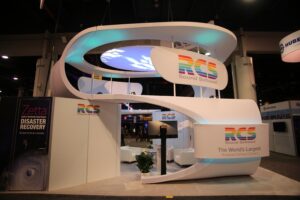

Incorporating theatrical or special effects lighting into an exhibit’s design is a HUGE trend, and it’s one that won’t be going away any time soon. Exhibitors are using lighting in a multitude of ways: to accent products and displays, to lead attendees down a path to complete the exhibitor’s desired tasks, or to beautifully accent minimalistic graphics on the booth.
Something to keep in mind if your brand decides to incorporate lighting into your exhibit is that convention centers are shutting lights off in spaces to conserve energy which creates dark spots, or they’ve not yet made the switch from super-hot halogen to LED lighting, all of which can adversely affect the way your booth looks in the hall. To compensate for these changes, exhibitors are moving to LED lighting to conserve energy, better control the light temperature to create a beautiful glow and illuminate graphics to give them a pop.
Depending on where you’re exhibiting, the color and temperature of the lighting in the hall can affect the way your lighting will display on your booth. “Pay attention to the hue of the lighting in the show’s hall. Different hues can completely change the coloring of the lights on your booth, ultimately affecting your overall look,” said Aaron Scarlata, Account Executive for Exhibit Concepts.
Prior to the show, Beckstedt recommends calling the show hall to find out what type of lighting you’ll be dealing with once the booth is ready to rock-and-roll.
Using lighting to accent products or graphics, or by creating a path for attendees to see something specific is an excellent way to capture the eyes of onlooking prospects. If you’re not already incorporating lighting into your booth, get with your exhibit house to strategically plan how your booth will “glow up”.
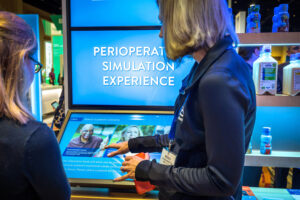

Technological advances in the last decade has given many marketers gobs of information about their audiences, their interests, and what led them to convert. When it comes to a trade show, tracking data isn’t a new phenomenon; it’s how we track the data that has become trendy.
Exhibitors are exploring new ways to capture information, whether it’s through Bluetooth or RFID tags integrated into the booth’s design, creative solutions to capture attendee engagement is a trend that will become best practice before we know it. Relying on busy booth and sales staff to capture the data alone is difficult and finding ways to automate the process is key in a fast-paced environment.
“Data becomes especially important if it’s about the customer experience and if the brand was effective. If an exhibitor wants people in a specific booth spot, the analytics help them figure out how to bring people there and once they’re there, identify if sales is helping them through the brand’s experience,” said Scarlata.
Matlock also notes that combining engagement and analytics is an effective way to capture data.
“Surveying attendees after they’ve sampled a product is a great example of engaging data capture. In Omron’s booth, we’re using survey technology to get people’s take on the harmonization of humans and machine. This is a great way to make attendees feel like they’re being included in the conversation, rather than just being talked to by booth staff,” said Matlock.
As people come in and out of the booth, having a plan to capture the right information is becoming more important as marketers think of creative and innovative ways to get their attention and meet their needs. While using different data collection technologies is trendy, it also determines whether your brand will sink or swim on the trade show floor or online. Make sure you’re talking to your exhibit house about how to best capture the data your brand needs to tell a compelling story across all your marketing efforts.
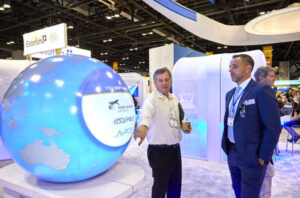

Rather than purchasing secondary space for meetings, exhibitors are making use of their own real estate by incorporating meeting space into their booth. The sole purpose of a trade show is to come face-to-face with prospects and having two different spaces to meet can make that challenging, especially if you’re forced to book space outside of the show hall.
These meeting spaces aren’t limited to conversations that were scheduled prior to the show. By incorporating welcoming lounge space, attendees will likely feel more willing and comfortable to have a conversation. “Rather than building a demo station or having booth workers engage with attendees standing up, I’m seeing more of these lounge and casual spaces being set-up so that exhibitors can reacquaint with customers or welcome and engage new people,’ said Scarlata.
In the last year, we’ve seen several clients take advantage of meeting space in their booth. Most notably, World Fuel’s large trade show booth provided 24-26 work spaces for FBOs (Fuel Based Operations) to meet and work with prospects, and LG Air Conditioning Technologies USA, utilized a 2-story rental meeting space that also created cost efficiencies, as it took up no additional real estate in their space.
Talking with new vendors or business can be daunting for show attendees, and they have tons of brands vying for their precious attention. By giving your space the feel of a cozy living room and cutting out a secondary location, you’ll be able to engage and relax prospects that may not have felt quite ready to convert.
As we near the end of 2019, trends will continue to change, and we guarantee we’ll be keeping our eyes peeled and our clients educated as we enter 2020. As you make plans for the rest of the year and next, make sure you’re keeping an eye on the trends so that your booth can compete. Need help refreshing your booth or engagements? Let’s brainstorm!


